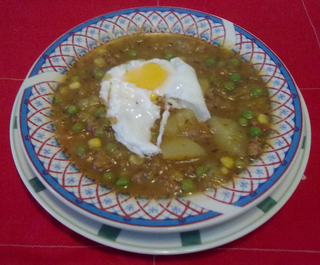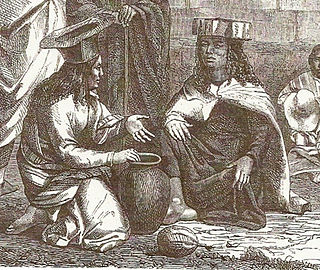
The llama is a domesticated South American camelid, widely used as a meat and pack animal by Andean cultures since the Pre-Columbian era.

Jerky is lean trimmed meat that has been cut into strips and dried (dehydrated) to prevent spoilage. Normally, this drying includes the addition of salt to prevent bacteria growth before the meat has finished the dehydrating process. The word "jerky" derives from the Quechua word ch'arki which means "dried, salted meat". All that is needed to produce basic "jerky" is a low-temperature drying method, and salt to inhibit bacterial growth.

Quechua people or Quecha people, may refer to any of the indigenous people of South America who speak the Quechua languages, which originated among the indigenous people of Peru. Although most Quechua speakers are native to the country of origin, there are some significant populations living in Ecuador, Bolivia, Chile, Colombia and Argentina.

Chuño is a freeze-dried potato product traditionally made by Quechua and Aymara communities of Bolivia and Peru, and is known in various countries of South America, including Argentina, Bolivia, Chile and Peru. It is a five-day process, obtained by exposing a bitter, frost-resistant variety of potatoes to the very low night temperatures of the Andean Altiplano, freezing them, and subsequently exposing them to the intense sunlight of the day. The word comes from Quechua ch'uñu, meaning 'frozen potato'.

Dried meat is a feature of many cuisines around the world. Examples include:

Anticuchos are popular and inexpensive meat dishes that originated in the Andes during the pre-Columbian era, specifically in the Antisuyu region of the Tawantinsuyu. The modern dish was adapted during the colonial era between the 16th and 19th centuries and can now be found in Peru.

Charquicán is a stew dish that is popular in Chile, Peru, Bolivia and other countries in the Andean region.

Inca cuisine originated in pre-Columbian times within the Inca civilization from the 13th to the 16th century. The Inca civilization stretched across many regions, and so there was a great diversity of plants and animals used for food, many of which remain unknown outside Peru. The most important staples were various tubers, roots, and grains. Maize was of high prestige, but could not be grown as extensively as it was further north. The most common sources of meat were guinea pigs and llamas, and dried fish was common.

Incan agriculture was the culmination of thousands of years of farming and herding in the high-elevation Andes mountains of South America, the coastal deserts, and the rainforests of the Amazon basin. These three radically different environments were all part of the Inca Empire and required different technologies for agriculture. Inca agriculture was also characterized by the variety of crops grown, the lack of a market system and money, and the unique mechanisms by which the Incas organized their society. Andean civilization was "pristine"—one of five civilizations worldwide which were indigenous and not derivative from other civilizations. Most Andean crops and domestic animals were likewise pristine—not known to other civilizations. Potatoes and quinoa were among the unique crops; Camelids and guinea pigs were the unique domesticated animals.

The Atacama people, known as atacameños or atacamas in Spanish and kunzas, Likan-antai or Likanantaí in English, are an indigenous people from the Atacama Desert and altiplano region in the north of Chile and Argentina and southern Bolivia.

Callalli District is one of twenty districts of the Caylloma Province in Peru and is located within the geographical area of the Colca Canyon.

A qullqa (Quechua pronunciation: [ˈqʊʎˌqa] "deposit, storehouse"; was a storage building found along roads and near the cities and political centers of the Inca Empire. To a "prodigious [extent] unprecedented in the annals of world prehistory" the Incas stored food and other commodities which could be distributed to their armies, officials, conscripted laborers, and, in times of need, to the populace. The uncertainty of agriculture at the high altitudes which comprised most of the Inca Empire was among the factors which probably stimulated the construction of large numbers of qullqas.

Pachamama is a goddess revered by the indigenous people of the Andes. She is also known as the earth/time mother. In Inca mythology, Pachamama is a fertility goddess who presides over planting and harvesting, embodies the mountains, and causes earthquakes. She is also an ever-present and independent deity who has her own self-sufficient and creative power to sustain life on this earth. Her shrines are hallowed rocks, or the boles of legendary trees, and her artists envision her as an adult female bearing harvests of potatoes and coca leaves. The four cosmological Quechua principles – Water, Earth, Sun, and Moon – claim Pachamama as their prime origin. Priests sacrifice llamas, cuy, and elaborate, miniature, burned garments to her. Pachamama is the mother of Inti the sun god and Mama Killa the moon goddess. Pachamama is said to also be the wife of Inti, her son.

Olluquito, olluquito con carne and olluquito con ch'arki are traditional dishes in Peruvian cuisine made with ulluku a root vegetable that also has edible leaves. It is an important root crop in the Andean region of South America, second only to the potato. The leaf and the tuber are edible; the leaves are similar to spinach, and the root is not unlike a potato or jicama. The Ulluku contains high levels of protein, calcium, and carotene. Papalisa were used by the Incas prior to arrival of Europeans in South America. It can be served with meat.
Tasajo is a cut of dried beef, normally cooked over a wood fire.















